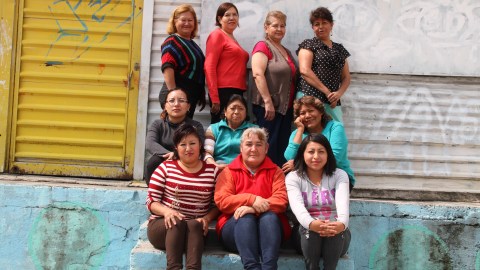When Repatriation Is a Means of Survival for Desperate Mothers
Mexican returnee joins a self-help cooperative to learn new skills and get a job that allows her to support herself

Mujeres migrantes conforman el Grupo de Artesanos de Cuautepec. Crédito: Gardenia Mendoza | Impremedia
MEXICO. – A child is a child. Maria Elena Ayala blessed her four boys, already adults and raised in the United States, packed a few belongings she had in Anaheim, Calif., and returned to Mexico in a show of solidarity with her one child that had been repatriated.
It was on a road raid on route to Texas. He was 17 years old and had never been to Mexico since his mother took him to the other side of the border, when he still was a baby. That is why he did not remember anything of Mexico City where he was born, much less of Arcelia, Guerrero, the only place where he had a family to welcome him.
“He became deeply depressed, he did not go out, did not talk to anyone, so I repatriated myself to be with him,” recalls 56-year-old Maria Elena.
Seven years later, in Mexico City, she is looking for another chance every day. Gradually, a way has opened for her and her son, who now works at a call center, selling package tours to Europeans in English. The boy is bilingual, young and smart, but he only makes 450 dollars a month and the mother must support him.
Via Maria Elena’s incessant search, she came upon an organization that integrates repatriated and divided families between two countries. Artesanas de Cuautepec (Artisans of Cuautepec) is a work group that seeks to address in the most dignified way possible the “violent” process of returning to Mexico from the United States.
“Whether by choice or deported, repatriation is always very shocking for migrants and even more if they are women,” explains Marco Castillo, of the Popular Assembly of Migrant Families (Apofam), an organization that supports the reintegration of returnees, and other services. So we have tried to replicate the model of self-help elsewhere.”
We Are Thousands
Every year thousands of women return to Mexico forcibly: either due to family ties or due to deportation, although only the latter has an exact figure detailed by the National Institute of Migration. During 2015, for example, the forced return of 21,322 migrants, mainly from Oaxaca, Michoacán, Guerrero, Guanajuato and Mexico City, was recorded.
Artisans of Cuautepec is a work cooperative made up of between 15 and 20 women living in a homonym suburb north of Mexico City, where they meet twice a week to manage a savings account and make handcrafts that are later sent to United States with their families or sold in various stores.
It’s Wednesday afternoon, a day usually dedicated to crunching numbers in the classroom where they regularly meet.
Fifty-seven-year-old Domitila Aguilar is one of the most active members since she left her life, her husband and children back in New Jersey. She is now almost alone, except for her mother, the reason she returned. “One day she called me and said ‘God bless you, daughter, I think I’ll die, say goodbye to my grandchildren.'”
The decision was taken without thinking, hastily. She returned: a mother is a mother: she was not going to let her die alone, without seeing her personally, without touching her. “From one day to another I was in Mexico. It’ll be two years,” she recalls.
Finally her mother improved: diabetes has ups and downs and when Domitila realized about the problem, she looked up to heaven and said, ‘Oh my God, now what do I do here?’
“My kids tell me to come back but there are many risks at the border: they won’t take you across if you don’t carry those small drug bags with you and border patrol is more severe every day.”
Her only hope now lies on her husband, who is a resident and is going to become citizen to be able to claim her as his wife, but it takes at least five years. Meanwhile, Domitila makes cute bags with recyclable material that her husband sells in New Jersey and then sends dollars that are milled gold in times when the peso (Mexican currency) is devaluated.
Collateral Damage
Isabel Avila has spent several years going around with the group. She is no deportee, but another victim of the migration phenomenon, like many of these ladies. One of her children was repatriated and since then has not been able to “get back on his feet”, while two children of hers remain in Tennessee, living as undocumented citizens who have not returned to their country in 17 years – and she misses them, dearly.
Isabel Ávila is trying to get a visa to see her children.
Her hope is that the American Embassy will grant her a humanitarian visa to visit them: every year these organized women, and others, through Apofam, send a few entry permits for elderly and sick mothers, desperate to see their children living on the other side of the border.
While the process undergoes, Isabel learns to knit. They could also study methods of jewelry, photography and silkscreen: all options at Artisans of Cuautepec. “The idea is to be increasingly independent because at our age they no longer give us jobs.”
Here she learned that in Mexico City there is unemployment insurance for Mexicans who returned and a federal fund for migrants’ productive projects.
Her son could apply for this type of support because he wanted to come back as soon as he was deported but he fell out of a ladder and broke his feet. “Now he must stay, accept that he is here and, we’ll move forward!”
Returnees in Figures
Total Statistics
207,273
Women: 21,322
Men: 185,951
Returnee women aged 12 to 17: 112
Home states with highest number of deported women:
- Oaxaca: 1,283
- Michoacán: 1,155
- Guerrero: 1,104
- Guanajuato: 1,051
- Mexico City: 550




